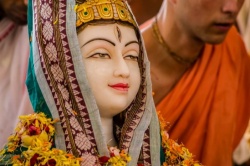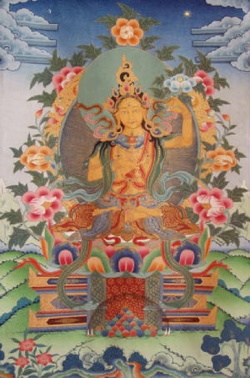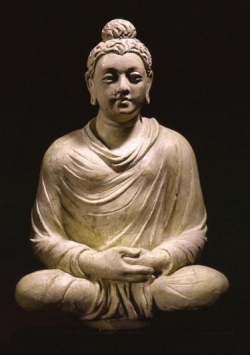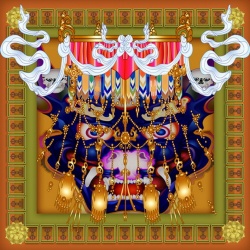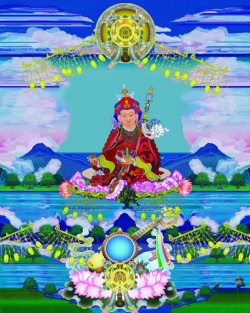Introduction to Shingon Buddhism
by Doug
Recently, in my trip to Japan in January, I had a small but interesting encounter at a Shingon Buddhist temple in Ebina, Japan called Kokubuji, and came away with a nice journal of Shingon Buddhist studies.1 So I’ve been reading some of the articles in this journal and wanted to share one article in particular that provides an excellent overview of Japanese Esoteric Buddhism. Esoteric Buddhism is mostly associated with the Shingon sect of Buddhism, since Shingon is purely esoteric Buddhism, while other only sects mix elements of esoteric Buddhism. However, in Japan, people usually don’t call it Shingon Buddhism, they just call it mikkyō (密教). This confused me a lot at first because I’d be saying “Shingon”, while others would say “Mikkyo”. We were kind of talking past each other.2 :)
The article in the journal, entitled “Esoteric Buddhism: A Definition” by Matsunaga Yūkei, explains what Shingon Buddhism is by explaining five aspects: mysticism, synthetism, symbolism, soteriology and realism. Let me try to summarize each of the five points he covers:
Mysticism
What makes Shingon “mystic” is that it emphasizes religious experience over doctrine and theory. Shingon is not the only sect to do this, but Shingon emphasizes it heavily. Buddhism teaches, for example, that there is not permanent, separate identity we can call a “self”, hence the ancient Pali term anattā (no-self). However, if you try to understand this through logic, you might get confused and think there’s nothing there either. That would be nihilism, and the Buddha didn’t teach that either. Instead, the Buddha taught that if you want to understand what you really are, you have to explore the mind, understand how reality works and so on. You can’t “think” your way to realization, you just realize it or you don’t.
So, in Shingon, there’s not a lot of material on what they teach because they believe you have to experience it, with guidance from a qualified teacher. If you try to experience it yourself, you can get confused, or worse, think you’re enlightened when you’re not.3 The teacher helps lead you along, steering you away from pitfalls, and keeping you from jumping ahead. The article mentions Saicho, the founder of Tendai Buddhism, who borrowed lots of texts from Kukai the founder of Shingon. Eventually, Kukai refused to lend specific texts to Saicho, and they were no longer friends. The article states that Kukai did not do this to punish Saicho, but rather, Saicho had not underwent the proper progression of training, so he was not allowed to see the text yet. Saicho wanted to study the texts for research purposes, but Kukai felt that he would not appreciate them unless he followed the proper order of training.
So, long story short, if you really want to understand Shingon’s teachings, you just have to experience them in the correct order, under proper supervision.
Synthetism
A key feature of both Shingon (and Tendai) Buddhism is synthetism. Shingon Buddhism has many figures, deities, rituals and so on. If you look at the two mandalas that are important to Shingon Buddhism, the Womb Realm Mandala, or taizōkai mandara (胎蔵界曼荼羅) and the Diamond Realm Mandala, or kongōkai mandara (金剛界曼荼羅) they also include many figures, and are very complex.
The author of the article states that Shingon reflects a very “Asian” attitude toward religion where science, religion and “magic” all blend together, and nothing is thrown away. For example, in the West, both science and magic derived from earlier alchemy. In the case of Asia, many prominent Buddhists were also scientists or scholars in other fields. The author of the article points out a prominent Chinese monk named Yi-Xing(一行), who developed a remarkable calendar system for the Chinese lunar calendar, correcting many old mistakes. Yi Xing is revered in Shingon Buddhism as ichigyō (same characters).
So in the same way, with ritual and art such as the Mandalas, Shingon Buddhism absorbs many aspects of life. However, the author points out that in the process, Shingon Buddhism also refines just as Yi Xing above refined the existing calendar. Many of the figures in Shingon Buddhism were originally Indian deities, or Shinto deities from Japan, but Shingon incorporates them and gives them a Buddhist meaning. At the very center of Shingon Buddhism is the figure Maha-Vairocana Buddha, or dainichi nyorai (大日如来) who embodies the truth of the Dharma, of reality and so on. All the other figures, Buddhas, gods and so on are treated as manifestations of Maha-Vairocana Buddha on some level or another. Thus, you always see Maha-Vairocana at the center of a Shingon mandala, with other Buddhas, deities and figures branching out.
For example the famous Shingon ceremony of goma (護摩), which you can see here, involves the burning of a huge pile of wood, while chanting sutras, mantras and such. The ritual original began in India as the homa ceremony, used by Brahmin priests to make offerings to the gods. However, Buddhism changed the ritual to represent the burning of the spiritual defilements.
Symbolism
Shingon Buddhism has lots, and lots of symbols, and it can be overwhelming, especially when Buddhism is about calming the mind, being untangled from life and so on. Why so much symbolism? The article states that Shingon, like the rest of Buddhism, teaches that the ultimate truth cannot be expressed in words. As stated above, it’s something that must be experienced. So how you teach the ineffable to someone who doesn’t know it? That’s where Shingon uses symbols and rituals: to convey the truth.
In one of the key texts of Shingon, the Maha-Vairocana Sutra, Maha-Vairocana Buddha states that because people’s minds naturally cling to forms and objects, he teaches the Dharma using symbols and forms to lead them to higher truths, where they can learn to see past them. The sutra clearly states that all these symbols and forms are empty, but they are medium to reaching the truth.
Also, different people have a different disposition, so someone may learn Buddhism through one symbol, but it may not be as effective with someone from a different disposition. So, many symbols exist in Shingon to help people of many different types. However, as stated above, you can’t just pick something you like. A qualified teacher will guide you along, understand your inclinations, and teach symbols that are suitable for you. Each person just needs the proper training and the right trigger.
The most famous symbols are the mandalas, but the author points out that many types of mandalas exist in Shingon. Not all of them are works of art. In his words:
…but one may go so far as to say that a breath of wind, the gurgling of a stream, and motion of the stars and moon are all examples of ‘action mandalas’ — they are all manifestations of the activity of the Universe, as such have symbolic significance.
Soteriology
The author then states that Shingon Buddhism is a religion of salvation. Like all Mahayana Buddhism, it is concerned with helping all beings become enlightened, but the approach to salvation is somewhat different than the Pure Land Buddhist sects, as the author points out. One of Kukai’s most important teachings was the notion of sokushin jōbutsu (即身成仏), or “becoming a Buddha in this very body”. Kukai taught that this very body is identical to a Buddha, the only difference is in understanding.
So, Kukai taught that it was important to cultivate the Three Mysteries, or sanmitsu (三蜜): body, speech and mind. For the body, one uses ritual gestures or mudra. For speech, they recite a mantra, and for the mind, they visualize an important image. If these three are done properly, and in harmony with each other, then it is taught that the Buddha Maha-Vairocana bestows a kind of ‘grace’ on the practitioner (lit. adhiṣṭhāna in Sanskrit). The term adhisthana is not unique to Shingon Buddhism, but is used in many other aspects. The key here is that the practitioner, through ritual and mind training, interacts with the “power” of the Buddha. It goes beyond the dichotomy of self-power and other-power.
From here, this spark of awakening is further cultivated in deeper and more advanced practices, leading the person out of the darkness of ignorance, hatred and greed into a more wholesome and wise view of life.
Realism
At the same time, Shingon emphasizes a pragmatic approach to life, according to the author. Shingon Buddhism, in keeping with Mahayana Buddhism, focuses less on renunciation from the world, and more on engaging it. The author points out that this is very separate from the idea that one can just indulge in the pleasures of life. For example, during the Kamakura period of Japan there lived two Shingon monks named Eison (叡尊, 1201 – 1290) and Ninshō (忍性, 1217 – 1303) who developed a reputation for their efforts in social works.
The author mentions a phrase used in Shingon Buddhism is sokuji nishin (即事而真), which means “the phenomenal world is identical to the truth”, so the focus is on engaging the world and learning through it. In Shingon training, one does withdraw from the self-centered view of the world through training, and learns to see life differently, and from this they engage the world not in a selfish way, but in a selfless one. The author points out that the practices are not as austere as found in Tendai Buddhism, including the famous kaihōgyō (回峰行) ceremony, which involves perambulating Mt. Hiei 1,000 days in a row as shown here.4 The author believes that this is due to Shingon’s heavier emphasis on engaging the world.
Conclusion
The author concludes by saying that all five of these aspects can be found in any branch of Mahayana Buddhism, be it Zen, Tibetan, Pure Land, Tendai, Nichiren or others, but Shingon simply combines these aspects in its own way. So, the key is understanding how Shingon employs them, not whether they exist or not in this framework.
Hope this is useful to others! I’ll write more as I digest other articles in this journal.
Namu Daishi Henjo Kongo
P.S. For more information, check out these websites, offered by different branches of Shingon Buddhism:
1 Bulletin of the Research Institute of Esoteric Buddhist Culture (Mikkyō Bunka Kenkyūsho Kiyō), Special Issue 1990 if you’re looking for it.
2 Technically, mikkyō can mean any secret, esoteric Buddhism either in Shingon, Tendai or others, but in Japan most people know that Kukai, founder of Shingon, is the one most associated with mikkyō. So it’s basically the same.
3 Plenty of people have thought this, and done some pretty harmful things.
4 That’s a very extreme example though. Most Tendai monks do not undergo that challenge.
